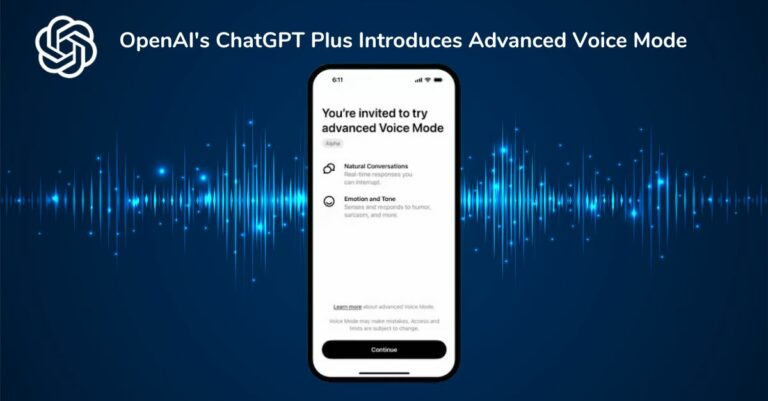New Update Could Blend Voice and Visuals Seamlessly
OpenAI’s ChatGPT is gearing up for another big evolution. According to new findings from a recent Android APK teardown, the AI assistant’s voice mode may soon support rich in-chat content integration, including maps, clickable links, and media previews — creating a more natural voice-and-visual experience.

The report by Android Authority uncovered hidden code within an unreleased ChatGPT build (version 1.2025.294) suggesting that users will soon be able to interact with ChatGPT’s voice mode directly within the main chat window, making it significantly more convenient than the current full-screen version.
Voice Mode 2.0: What’s Changing in ChatGPT
A More Immersive, Unified Chat Experience
Currently, ChatGPT’s voice conversations take place in a full-screen interface that hides text and rich visuals. This design limits contextual awareness since users can’t see links, messages, or examples while speaking with the chatbot. The upcoming upgrade aims to fix that.
According to the code findings:
-
Voice mode will integrate within the main chat screen.
-
Users will see new buttons to end a conversation or mute/unmute the microphone.
-
Rich content such as maps, web links, and references will appear inline during voice conversations.
This means ChatGPT will soon combine spoken interaction with visual information updates, letting you ask questions, hear responses, and see related insights — all at the same time.
Behind the Update: What the APK Teardown Reveals
The APK teardown by Android Authority uncovered multiple references describing “voice overlay integration”, “mute control,” and content embedding for maps and link previews.
A short demo video shared by the publication showed a redesigned user interface that keeps the chat visible during voice sessions instead of switching to a full-screen voice-only mode.
The new design reflects OpenAI’s mission to make ChatGPT feel more interactive and human-like — an assistant that can talk, listen, and show relevant visuals all in one continuous thread.
ChatGPT’s Visual Revolution: From Text to Rich AI Responses
ChatGPT’s Growing Multi-Modal Power
The rumored voice upgrade builds upon OpenAI’s ambitious multi-modal approach. The company has been expanding ChatGPT beyond text — adding tools for images, voice, browsing, and video generation.
For context, recent updates include:
-
ChatGPT Atlas: OpenAI’s first AI web browser, built with the GPT-5 model, currently available for macOS.
-
Sora 2 AI Video Generation: Users can now generate AI-driven videos directly via the ChatGPT web interface.
-
AI Shopping and Instant Checkout: New “agentic” features allow users to purchase products within ChatGPT chats using AI-curated suggestions.
-
ChatGPT Pulse: Personalized feed summarizing daily insights and trending topics for users.
Each update reflects OpenAI’s push to transform ChatGPT into a full-service digital assistant positioned far beyond typical chatbots.
Why the Rich Content Integration Matters
A Step Toward Natural AI Conversations
By bringing visual and interactive elements to voice mode, ChatGPT bridges the gap between conversation and comprehension.
With maps, links, and contextual previews, users can visualize answers — like directions, nearby places, or website recommendations — without needing a split interface or switching modes.
For example:
-
Asking for “closest vegan restaurants” could prompt voice narration plus map previews.
-
Requesting “a summary of NASA’s latest mission” might show hyperlinked news articles alongside spoken explanations.
This evolution moves ChatGPT closer to the AI assistant ideal — conversational, visual, and deeply contextual.
When Will ChatGPT’s New Voice Features Launch?
Still in Development, Public Rollout Expected Soon
While OpenAI hasn’t announced an official release date, the existence of these features in the ChatGPT Android codebase suggests internal testing is already underway.
Typically, OpenAI pushes new interactive features first to ChatGPT Plus or Pro users before global access. Analysts predict the integrated voice interface could roll out in early 2026.
Given the pace of updates — from AI-powered browsers to multimodal video generation — it’s likely this feature will debut as part of ChatGPT’s 2026 release roadmap, possibly alongside new GPT-5 enhancements.
OpenAI’s Growing Ecosystem: More Than a Chatbot
Altman’s Vision for Agentic AI
OpenAI, led by CEO Sam Altman, has been redefining the frontier of AI interaction. From the GPT-5 model powering ChatGPT Atlas to AI-driven commerce features like Instant Checkout, the company is moving toward what Altman calls “agentic AI” — systems capable of autonomously completing multi-step tasks across speech, text, and web functions.
The newly enhanced voice mode appears to be a vital step in this direction — a conversational hub combining speech recognition, retrieval-augmented insights, and real-time content visualization.
ChatGPT’s upcoming voice mode upgrade signals the next evolution in AI communication — one where words meet visuals. The ability to see embedded maps, clickable links, and summaries during a live conversation removes a long-standing barrier between spoken AI interaction and information-rich usability.
As OpenAI ushers in this new era of voice-driven, content-integrated experiences, ChatGPT continues to position itself not just as a chatbot — but as a visual, auditory, and actionable AI assistant designed for the future of human-computer interaction.




